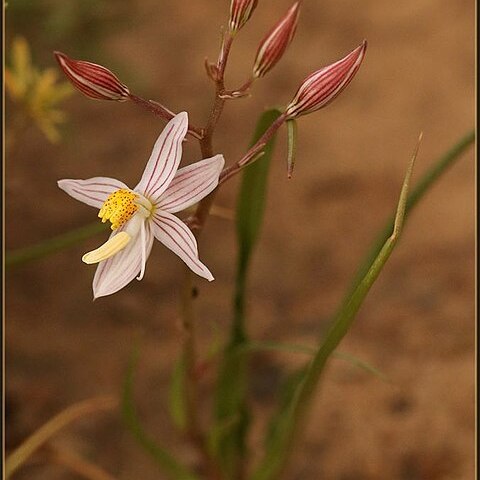Plants (120-) 150-350 mm high. Corms moderately to deep-seated, 20-25 mm diam., tunics of coarsely netted, fibrous, leathery or woody fibres, sometimes connate below into claws, extending shortly in a neck to 30 mm long, rarely into a fibrous neck to 100 mm long, brown. Basal leaves 4-15, suberect or spreading, linear-hemiterete to lanceolate, 30-200 (-250) x 2-15 (-20), acute to attenuate, leathery, plane or canaliculate, glabrous, margin smooth or ciliolate-scabridulous. Inflorescence a moderate or dense raceme up to 15-flowered, with 1-3 branches congested near base, thus emerging from among leaves, rarely with accessory branchlets and thus paniculate, lower pedicels 0.2-0.8 times their length apart; pedicels suberect, rarely arcuate or almost geniculate, 15-30 (-50) mm long; bracteoles mostly inserted between ± halfway and upper third, sometimes in basal third or subbasal. Flowers ± enantiomorphic, facing outwards, yellow or pink to purple, usually flushed darker on reverse, with dark veins, fragrant; tepals spreading, outer oblong-elliptic, 10-15 (-18) x 2-4 mm, apiculate, inner elliptic-ovate, 10-15 (-18) x 3-7 mm, acute, narrowed basally or very shortly clawed. Stamens dimorphic, 5 + 1; filaments of posterior cluster 2.5-4.0 mm long, connate only at extreme base, ± linear, yellow, anthers 2-4 mm long, yellow, usually finely spotted black or maroon; anterior stamen with filament deflexed ± laterally, 4-5 mm long, linear, connate to upper cluster at extreme base only, anther 4-7 mm long, thus ± twice as large as upper, yellow, brown or mauve. Ovary half inferior; style ± laterally deflexed to left or right opposite lower stamen, 6-10 mm long, not extending beyond lower anther. Capsules erect, subglobose-retuse, 6-8 mm diam., 3-lobed. Seeds ovoid, ± 2 mm diam., rugulose.
More
Perennial geophyte, 0.15-0.35 m high; corm tunics light brown, wiry to fibrous. Leaves 30-250 x 2-18 mm, in basal tuft, linear, glabrous, with prominent ribs, margins entire. Inflorescence a branched, lax raceme. Perianth: segments oblong, lanceolate, 12-18 x 2-4 mm, yellow, pink, often with maroon veins, occasionally maculate, apex acute to mucronate. Stamens 6; filaments yellow, 2.5 mm long; anthers spotted maroon or black, dehiscing by pore-like slits; 5 upper filaments free to base, with tubular anthers; 1 lower filament with spathulate anther. Flowering time Aug.-Dec. Fruit a globose capsule.
Cormous geophyte, 120-250 mm tall. Leaves lanceolate. Flowers on suberect pedicels, pink or yellow, fragrant, tepals 12-18 mm; anthers yellow, usually darkly spotted, 5 upper and 1 larger lower, filaments free; strongly enantiostylous.
Cormous geophyte, 12-25 cm. Leaves linear-lanceolate. Flowers in branched racemes, yellow, sometimes pink, fragrant, pedicels suberect, with 5 upper and 1 larger lower stamen, filaments free nearly to base.
A herb. It is a bulb or corm plant. It keeps growing from year to year. It grows 12-25 cm tall . The leaves are sword shaped. The flowers are on long spreading stalks that bend up at the end.

